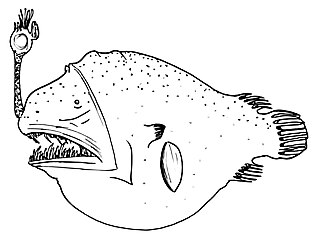
The footballfish form a family, Himantolophidae, of globose, deep-sea anglerfishes found in tropical and subtropical waters of the Atlantic, Indian, and Pacific Ocean. The family contains 23 species, all of which are classified in a single genus, Himantolophus.

Oneirodidae, the dreamers are a family of marine ray-finned fishes belonging to the order Lophiiformes, the anglerfishes. These fishes are deepwater fishes found in the Atlantic, Indian and Pacific Oceans, and it is the most diverse family of fishes in the bathypelagic zone.
Bertella is a monospecific genus of marine ray-finned fish belonging to the family Oneirodidae, the dreamers, a family of deep sea anglerfishes. The only species in the genus is Bertella idiomorpha and this can be distinguished from other members of the family by the structure of its hyomandibular bone.

The horned lantern fish or prickly seadevil is a species of marine ray-finned fish, it is the only species in the monotypic family Centrophrynidae. This species has a circumglobal distribution and is distinguished from other deep-sea anglerfishes by various characters including four pectoral radials, an anterior spine on the subopercular bone, and a short hyoid (chin) barbel in both sexes.

Acentrophryne is a genus of deep-sea anglerfish in the family Linophrynidae, the leftvents, known from the eastern Pacific Ocean. Fossils of the type species, A. longidens, have been found in Late Miocene-aged Puente Formation of Rosedale, California.

Linophryne, the bearded seadevils, is a genus of marine ray-finned fishes belonging to the family Linophrynidae, the leftvents. These deep sea anglerfishes are found in the Atlantic, Indian and Pacific Oceans.

Chaenophryne is a genus of marine ray-finned fish belonging to the family Oneirodidae, the dreamers, a family of deep-sea anglerfishes. These predatory, deep-sea fishes are found in the tropical and subtropical oceans around the world. Like other deep-sea anglerfishes, they are sexually dimorphic, with the matamorphosed females dwarfing the metamorphosed males. The males are not sexual parasites.
Chirophryne is a monospecific genus of marine ray-finned fish belonging to the family Oneirodidae, the dreamers, a family of deep sea anglerfishes. The only species in the gneus is Chirophryne xenolophus, the longhand dreamer. This species is known from a few locations in the Atlantic and Pacific Oceans.
Ctenochirichthys is a monospecific genus of marine ray-finned fish belonging to the family Oneirodidae, the dreamers, a family of deep sea anglerfishes. The only species in the genus is Ctenochirichthys longimanus is known only from two locations, on in the Atlantic Ocean and the other in the Western Pacific Ocean.

Danaphryne is a monospecific genus of marine ray-finned fish belonging to the family Oneirodidae, the dreamers, a family of deep sea anglerfishes. The only species in the genus is Danaphryne nigrifilis which is found in the tropical and temperate regions of all of the world's oceans.

Dermatias is a monospecific genus of marine ray-finned fish belonging to the family Oneirodidae, the dreamers, a family of deep sea anglerfishes. The only species in the genus is Dermatias platynogaster which is known from 4 metamorphosed female specimens collected from 3 widley sparated localities in the Western Pacific Ocean.
Dolopichthys is a genus of marine ray-finned fish belonging to the family Oneirodidae, the dreamers, a family of deep sea anglerfishes. These predatory, deep-sea fishes are found in the tropical and subtropical oceans around the world.

The plainchin dreamarm is a species of marine ray-finned fish belonging to the family Oneirodidae, the dreamers, a family of deep sea anglerfishes. It is the only species in the monospecific genus Leptacanthichthys. This species occurs in the North Atlantic and North Pacific Oceans at depths down to 2,000 m (6,600 ft).
Lophodolos is a genus of marine ray-finned fish belonging to the family Oneirodidae, the dreamers, a family of deep sea anglerfishes. These predatory, deep-sea fishes are found in the tropical and subtropical oceans around the world.
Microlophichthys microlophus, the short-rod anglerfish, is a species of marine ray-finned fish belonging to the family Oneirodidae, the dreamers, a family of deep sea anglerfishes. This anglerfish is found in the deeper waters of the tropical and temperate oceans around the world.
Microlophichthys is a genus of marine ray-finned fish belonging to the family Oneirodidae, the dreamers, a family of deep sea anglerfishes. The species in this genus are found in the tropical and subtropical parts of the Atlantic, Indian and Pacific Oceans.

Oneirodes is a genus of is a genus of marine ray-finned fish belonging to the family Oneirodidae, the dreamers, a family of deep sea anglerfishes. These predatory, deep-sea fishes are found around the world. This is the type genus, and the most speciose genus, of the family Oneirodidae. They are sexually dimorphic but, like most taxa within their family, the small males are free living and are not sexual parasites on the larger females. Only the females are used to identify the species in this genus as no species specific charaxcters have been found for males.

Pentherichthys is a monospecific genus of marine ray-finned fish belonging to the family Oneirodidae, the dreamers, a family of deep-sea anglerfishes. The only species in the genus is Pentherichthys atratus which is found in the bathypelagic zones of the tropical and subtropical Atlantic, Indian and Pacific Oceans. The males of this species are dwarfed and are not parasitic on the females.

Chaenophryne longiceps, the can-opener smoothdream, longhead dreamer or smooth-head dreamer, is a species of marine ray-finned fish belonging to the family Oneirodidae, the dreamers, a family of deep sea anglerfishes. This predatory, deep-sea fish is found in tropical and subtropical oceans around the world. Like other deep-sea anglerfishes, it is sexually dimorphic with the metamorphosed females dwarfing the metamorphosed males, though the males are not sexual parasites.
Chaenophryne melanorhabdus is a species of marine ray-finned fish belonging to the family Oneirodidae, the dreamers, a family of deep-sea anglerfishes. This predatory, deep-sea fish is found in the Pacific Ocean. Like other deep-sea anglerfishes, dreamers are sexually dimorphic, with the matamorphosed females dwarfing the metamorphosed males. The males are not sexual parasites.













